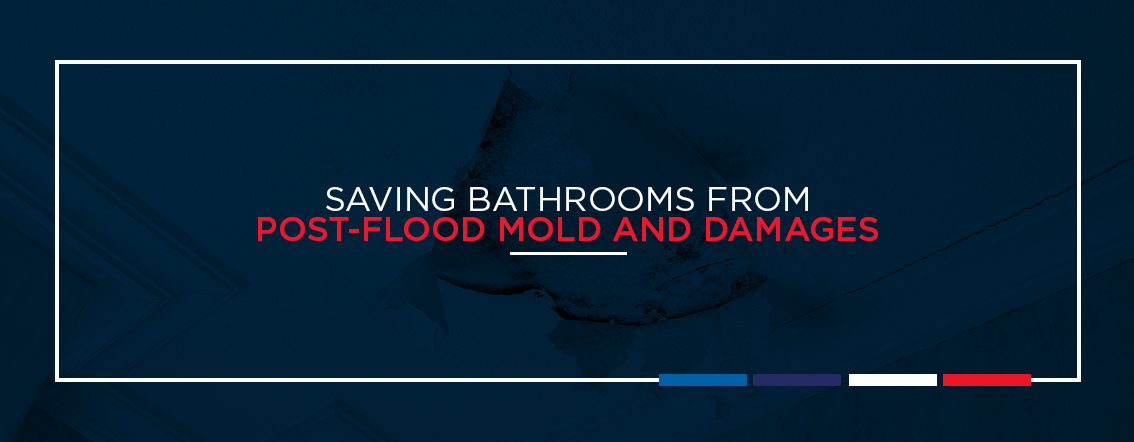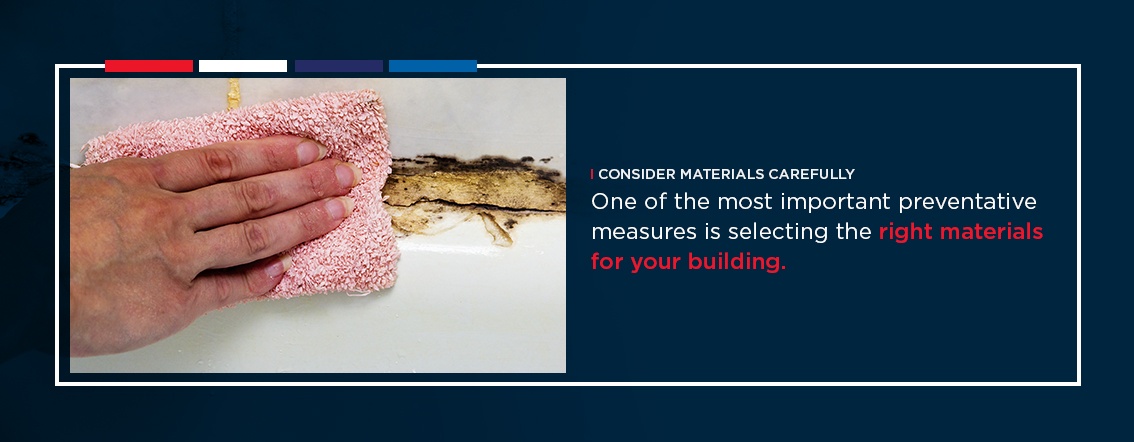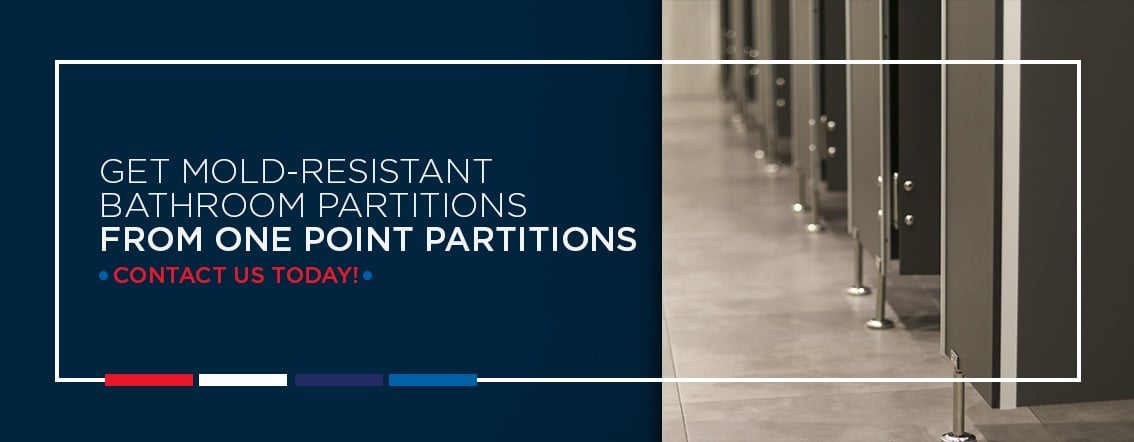Saving Bathrooms From Post-Flood Mold and Damages
Floods are the most common natural disaster in the United States. While floods themselves pose a host of obvious dangers, such as injury or property damage, some of the worst building problems caused by floods largely go unnoticed.
Mold can start growing in your facility as early as 24 hours after the initial exposure to water build-up. At best, mold triggers allergy symptoms in the upper respiratory system. At worst, mold can cause long-term damage and can pose extreme dangers to those with asthma and compromised immune systems.
Whether you’re remodeling after a flood or doing your research before disaster strikes, this guide will give you tips on what preventative measures to take and where to look for mold after a flood.
Preparing Your Facility
As with any disaster, the best way to deal with the aftermath is planning before disaster strikes. These preventative measures extend beyond the bathroom, playing an important role in the health of every room in the building.
Take a walk through your facility and see what you can accomplish on your own. For more extensive measures, talk with your engineers or contractors on addressing these issues:
- Give your sump pump back-up power.
- Have an off-site back-up for your computers.
- Elevate expensive equipment.
- Improve your site’s drainage.
- Inspect your check valves routinely to make sure they are in working order.
Some of these steps can be addressed once, but others need on-going maintenance and care. Stay on top of this to-do list, especially during flood season, to make sure your business can prepare itself for possible danger.
Having a manual checklist or electronic calendar reminders for specific personnel to fulfill particular checking roles will help ensure the building stays up-to-date on its safety checks.
Consider Materials Carefully
One of the most important preventative measures is selecting the right materials for your building. Porous materials will soak up the water and give mold a moist surface to grow on. When you select materials that are impervious to water, you give yourself a better chance to fight the mold. You will have an easier time cleaning these surfaces, and the water will not penetrate the surface to dampen and compromise the material.
Bathrooms, especially ones with working showers, are notorious for mold and mildew. The moist environment gives the mold a perfect place to take hold and begin growing.
Select materials that are:
- Non-porous: A porous material, such as unsealed wood, soaks up water. Even if the outside seems dry, the inside remains moist, giving mold the perfect place to grow from the inside out. Even worse, because the mold does not appear on the outside until much later, it generally goes undetected until it’s too late.
- Easy to clean: Routine disinfecting stops the spread of mold by killing the spores. When the surface gets disinfected and dried, the mold loses the moist surface it needs to grow and spread.
- Water impervious or at least water-resistant: When a material has a resistant seal against water, water will run off without soaking in. These surfaces are easier to clean, and since they don’t stay moist, mold doesn’t have a chance to grow on them.
Once you choose the right material for your location, follow up with routine cleaning. Meticulously disinfecting and properly drying the bathroom will stop the spread of mold by removing possible surfaces for them to grow on.
Where to Check for Mold
If disaster strikes and your building experiences a flood, it’s essential to start searching for potential mold spots immediately.
You need to complete this search meticulously because the microscopic organisms responsible for mold love finding cracks and crevices to hide inside. Anything dark and damp can quickly become a breeding ground for mold.
It only takes a few inches of standing water for the spread of mold to begin, and it only takes 24 hours for the process to start.
To keep your business’ bathrooms mold-free after a flood, you’ll need to:
- Remove and replace compromised surfaces: If you choose to keep a surface that has begun to grow mold, you’re only giving the material the chance to pass the spores to the rest of the room. For example, if a windowsill has become waterlogged, you’ll need to remove the molding and replace it with a water-resistant material.
- Dry out anything you can save: If you have surfaces that have the potential to survive the flood, immediately begin drying out the space. Bring in fans and de-humidifying blowers and open windows to get the moisture out of the air and off of the surfaces.
- Disinfect the salvaged spaces: After getting the initial water out of the air and surfaces, disinfect the areas you plan to keep. Use bleach on non-metal surfaces. For gentler disinfecting, try disinfecting cleaners and hydrogen peroxide. Ventilate the area properly during and after cleaning.
When beginning your bathroom inspection, make sure you thoroughly inspect these areas:
- Walls: With chips and cracks, even moisture-resistant walls can develop mold under the surface. You need to dry or remove insulation, which can easily absorb water and quickly grow mold.
- Doors: Whether or not you need to replace your door will depend on its material. Even if you have a door with a water-resistant exterior, if it has a center that accepts water, your door can quickly become an ideal location for mold to grow. For example, while a commercial metal door may appear dry, the interior can get trapped between the steel slabs. If you don’t know what the interior of your door is made of, do your research to know if you need to replace it. Also, pay close attention to door frames, which can easily absorb moisture, as well. You can easily replace these if needed.
- Carpets, curtains and drapes: Anything fabric has the potential to quickly become fully soaked in water. While you may not have any small rugs in the bathroom, drapes or curtains around the window could grow mold. It’s best to remove and replace these.
- Stall partitions: If your partitions — from urinal partitions to toilet stalls — are made from non-porous materials, you can easily clean them. However, if they are made of a material that is not water-resistant, you’ll need to replace them with something sturdier and safer for a flood.
Get Mold-Resistant Bathroom Partitions From One Point Partitions
As with most disasters, prevention plays the most significant role in mitigating the extent of damages. Before disaster strikes, make sure you build or remodel your business’ bathrooms with the right materials to make flood clean-up easy.
One Point Partitions offers damage-resistant bathroom partitions made with non-porous materials, making disinfecting and drying simple and quick after a flood. To learn more about how you can protect your business’ bathrooms against floor damages, contact us today to get the answers you need before it’s too late.



